
queloque
-
Posts
130 -
Joined
-
Last visited
Content Type
Profiles
Forums
Gallery
Events
Store
Posts posted by queloque
-
-
Origami2547, in your 1st picture, why did you go with a flex pipe with for draining??
And you said draining is 1 1/2 inch, right. I'm going to buy piping this weekend.
Thanks
-
I don't recommend that you go with ebay. Instead, go to a reputable vendor that will give you a great product, great price & great service. One of our sponsors, airwaterice.com is just such a vendor. They even give WAMAS members a discount (you have to look up the code to use). Head over and check out their reefkeeper systems. Many of us here run some variant of their 75 gpd Typhoon III.
Thanks...I placed an order with them.
-
Thanks. If this is not the appropriate place to post this request let me know. Thanks everyone.
-
A piece of egg crate on top of the baffle. You can find it easily at Home Depot, usually next to the lighting dept. They are made of plastic and come in 2 x 4 sheets. Extremely easy to cut pieces to fit your needs :-)
How do you hold it in place when on top of the glass?
-
What have been the other alternatives that people do to prevent the critters from crawling over?
-
The basics are fine. I would use a Durso-style overflow to provide some venting and to help quiet things some. I would add ball valves at both tank drains and returns. Personally, I use full union valves here so that I can overhaul the plumbing if required. You might also put a ball or gate valve on the pressure side of your return pump so that you can throttle it back from a single point if needed.
I'd use 1-1/2 inch minimum pipe for the merged drains . 1-1/4 inch minimum for the merged return.
If you submerge and "L" your return at your sump, it'll run quieter.
If you ever get to using an external pump, having valves and unions in line and close is very useful to facilitate pump cleaning, repair or replacement.
As I recall, you're planning on putting your sump in the garage, right? You may wish to consider several things in this case:
a) Impact on evaporation
b) Impact on temperature and the need for temperature control (especially in the summer if the garage gets particularly hot)
c) Vulnerability / access to accidental pollutants
1. I have the Durso style that came with the tank
2. On the Ball/gate valves from my diagram where should I place them exactly or ideally? - Well I guess I can see from your pictures you posted.

3. On the 1-1/2 and 1-1/4 are you saying the drain should have greater flow than the return?
4. Will do on the submerged with the "L".
5. You did mention The upright sanitary tee in your 3rd picture, would I need that?
As far as placing it in a garage, I already have a chiller from my 90 gallon so i will use that to maintain a constant temp.
The garage stays very cool through the summer.
Should I be concerned with exhaust from the car that is parked in the garage?
Thanks for all the advice.
I think I will go for a 55 to 75 tank as my sump/refugium. A glass company in Mananas said they can cut my baffles at $11 each.
-
So guys this is how a drew out my plumbing.
Is there something I need to add, take out, recommendations in terms of flow, size of pipe, switch off valves, prevention of gurgling sound, type of pump, etc?
The return to tank pipe might be at the most in length 10 ft give or take. I would lean toward less just to put them in perspective.
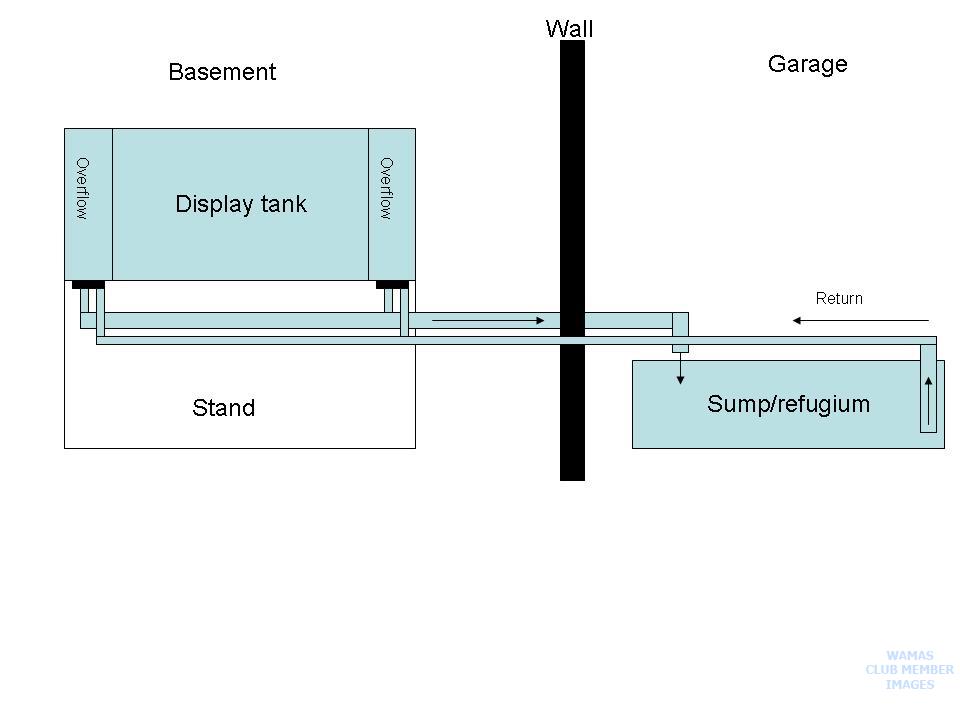
-
Ok, I have a question.
Should I run my horizontal pipe from the two overflows to sump with one pipe or two
and return with one pipe or two?
I guess basically what i'm asking is can the piping to and from be all done with two pipes through the wall and is that the most
efficient?
From the picture you can see I will be running pipe to the right of the tank and through the wall.
I think I will put two plants or some displays on each side of the tank to hide the pipe running across.
1. How low below the display tank before I elbow horizontally to the right through the wall?
2. Should the pipe be a a big slant downward toward the wall?
-
That's still code, I believe. If you need the pipe to empty completely after the water flow stops, that's advised as well. However, I don't need that to happen in my system (unless I'm completely draining it down), so I'm comfortable with the slight rise in the piping just before sump entry.
Queloque, if you'd like to see my setup sometime (I'm in Ashburn, just north of Manassas), I'd be happy to show it to you personally and to discuss some thoughts and to address some of your questions on the subject.
Thanks, I might have to take you up on that. What are the sizes of your piping and where do you strategically place your turn off valves and how many do you need?
-
9-1/2 horizontal feet. But, you may be missing the point, these horizontal runs could be 50 feet and it wouldn't make much of a difference. The water would flow even in this case.
Consider the following thought experiment: Imagine that you have a 50 foot garden hose going down your driveway. Now, grab the end of the hose at the top of your driveway and pour a gallon of water down into the open end of the hose. Look down at the other end of the hose - see the water coming out? Now put the hose on a level sidewalk and do the same thing. You'll get the same result as long as you're holding your end of the hose up higher than the drain end. That's gravity. The horizontal run is not all that important - there's some resistance, yes, but it's inconsequential given the short distances we're talking about as long as the pipe's diameter is large enough so that friction (due to fluid velocity) is not be a limiting factor. This is how water flows out out of your house, too. When water goes down the drain in your house, the distance traveled horizontally is often much, much longer than the vertical descent.
In the case of your aquarium overflow, there's water entering the high side of your overflow and it's applying pressure to the water already in the drain system. That water that's higher than the water in other parts of the pipe presses downward, through gravity, on the water that's below it, providing the motivating force to move water through the pipe.
Ok, so I just need to do is a lot of measuring and get the right plumbing. I'm still searching for a sump. I would like to keep it on a table but like you said it should be below the display so I guess it will sit on the garage floor.
-
Also I notice everyone using the rubbermade as a sump. How does that work with the use of a separate refugium. I'm used to people building or building a sump with baffles. Does this come out cheaper and easier?
-
Picture #1 looks under my 180 display at one of two drains. One of the descending pipes is a return, while the other is a drain. The one on the right is actually the return. You can see how the return line elbows back outside the stand to the wall that's behind the stand.

Picture #2 shows the drain in the last shot entering a PVC tee (1" flex PVC entering a 1.5" PVC Tee) and exiting the stand back toward the wall. There's a union between the tee and the wall.
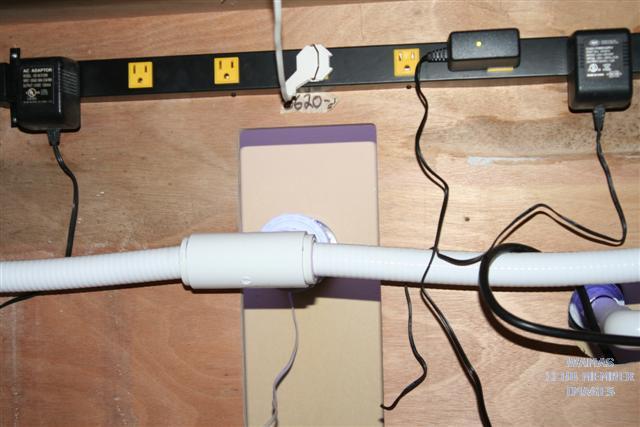
Picture #3 shows the drain (toward the center of the picture) passing into a sanitary tee on the other side of the wall. The upright above the sanitary tee is actually a vent, capped and drilled to keep the drain system quiet and flowing without siphon action. The flow of the water is to the right in this picture. Other system elements (a refugium and a frag tank) drain into the main horizontal run and the display is actually about the last system element entering the drain before it reaches the sump.
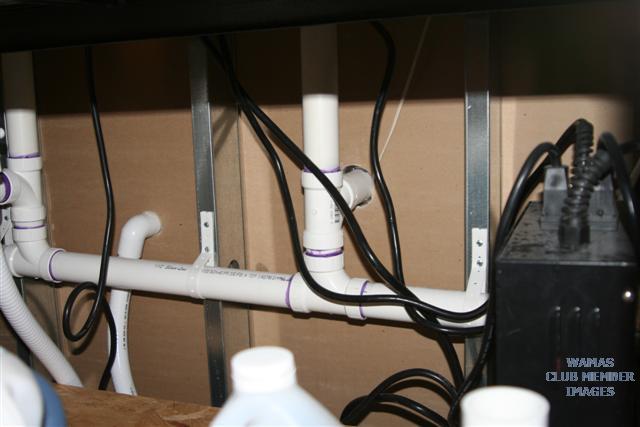
Picture #4 shows the drain line rounding a corner (twice) and entering the side of my 100 gallon Rubbermaid stock tank through a 1-1/2 inch bulkhead adapter. This is my sump. You'll notice that there's a slight rise in the drain line (which otherwise had been flowing 'downhill' in all the other pictures). Water enters the sump and makes a left turn, circulating water in the sump (clockwise when viewed from the top). You can also see how water is returned from my sump from the bulkhead adapter toward the bottom of the picture. While it looks like I'm taking water off the bottom of the sump, there's actually an upright pipe and strainer inside the sump that helps me take water from the middle of the water column in the sump. The return is made via the Reeflo Wahoo pump that is visible just beyond the valve in the center of the picture.
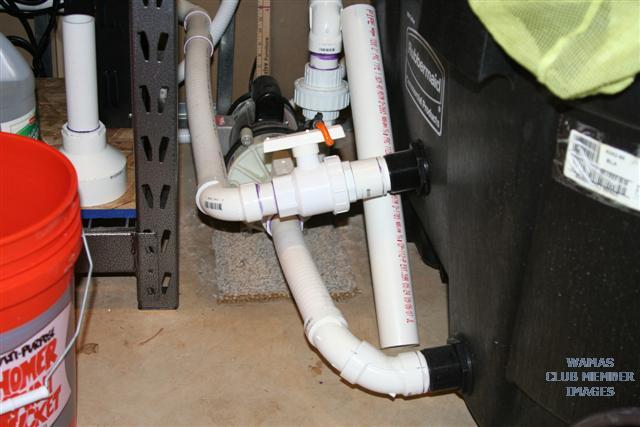
Picture #5 is an overview of my sump area. In the upper left of the picture, you can see some of my manifold plumbing that separates my water return to feed multiple systems (2 to the display, 1 to the refugium / frag tank combo, and one to a garden hose that's used for water changes. One port on the manifold is being held in reserve for expansion or whatever use I might have later on.) It looks like I need to empty the skimmer again!
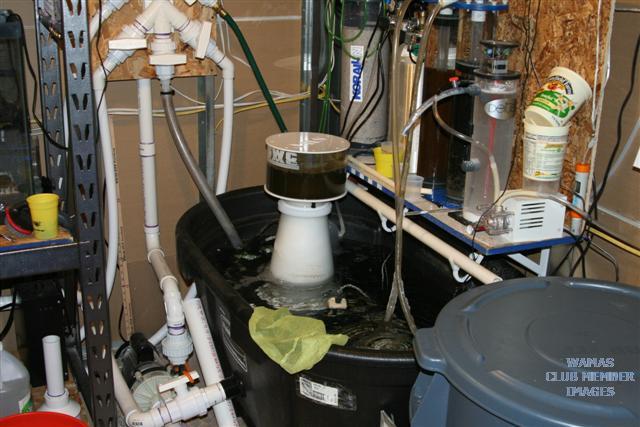
Questions?
I have a few questions.
So in picture 3 you said the flow of the water is to the right in this picture. What is the distance of this flow to the sump?
-
I can get a picture, sure.
A pump is not needed to get water to your sump if your sump is at a lower level than your display (as is almost always the case). You will have to have a pump, though, to return the water to your display.
Can I ask how long you've been contemplating your setup? Have you visited any other reefers' house to see their setup? We have several members in Manassas and one popular LFS (local fish store), Blue Ribbon Koi, is right off 234 outside town (toward 15). The staff there could show you a little bit about how their system is configured to help give you a sense of how plumbing works.
Let me take some pics....
I just bought the 125 this past weekend from someone and i'm migrating from a 90 gallon which had a hanging overflow. With my 90 gallon I had a small sump under the tank and found it very irritating and messy to work with and my stand for the 125 really doesn't allow me the ability to fit a large sump.
As far as visiting anyone's house, no. I'm new here recommended by a member. I do need to stop by Blue Ribbon which isn't far from me.
I'm still cleaning the tank and i'm migrating my 90 gallon from my ex-wifes house which is 90 miles away so I have to take things pretty slow and make sure that I get everything right before moving my fish and live rock over.
My t5's are coming in the mail so I would like to get the plumping and sump ready to go.
-
As long as the water exits lower than it enters the pipe and the pipe is full of water (that is, as long as there's positive head pressure), you'll have flow by gravity. Some parts of my drainage runs around 10 (horizontal) feet. My display drains into a sump in the next room with about a 10' maximum horizontal run as well.
Be aware that if you're pumping water back into the display from your garage-located sump, water will naturally flow into your overflow piping, thereby "pushing" water out into your sump.
Where are you located? You may wish to consider listing your location in your profile.
I'm in manassas. Do you have a pic of your setup? I really want a sump I can work on freely managing a refugium in the garage with no mess where the tank is.
So no pump would be needed? One friend suggested a smaller tank under my display tank than pump water from there to the sump in the garage but I cannot see that working if the tank is smaller than the sump in the garage.
-
I have a 125 gallon 6 foot long tank with two overflows, one on each corner. I would like to put my sump in the garage which is about 10 feet from the left overflow to the right of the tank throw a dividing wall to the garage. I don't think there is enough gravity to push the water that far horizontally, or is it?
Are there any examples of this type of plumping? Is there a pump that can pump the overflow to my sump inside the garage? I don't want a sump under the tank and I want a large sump.
I hope I explained this clearly, please let me know if I didn't.
Thanks.



Which reverse osmosis water filter from ebay would you recommend?
in Do It Yourself
Really? I emailed them and called. No response to my email and no call back.